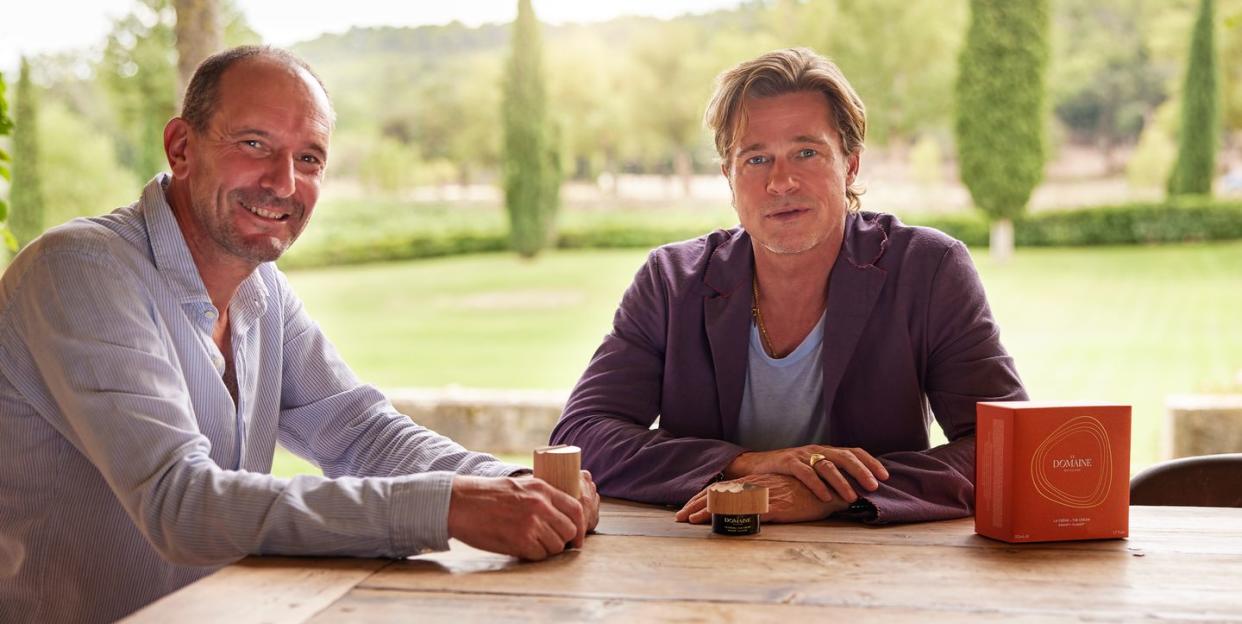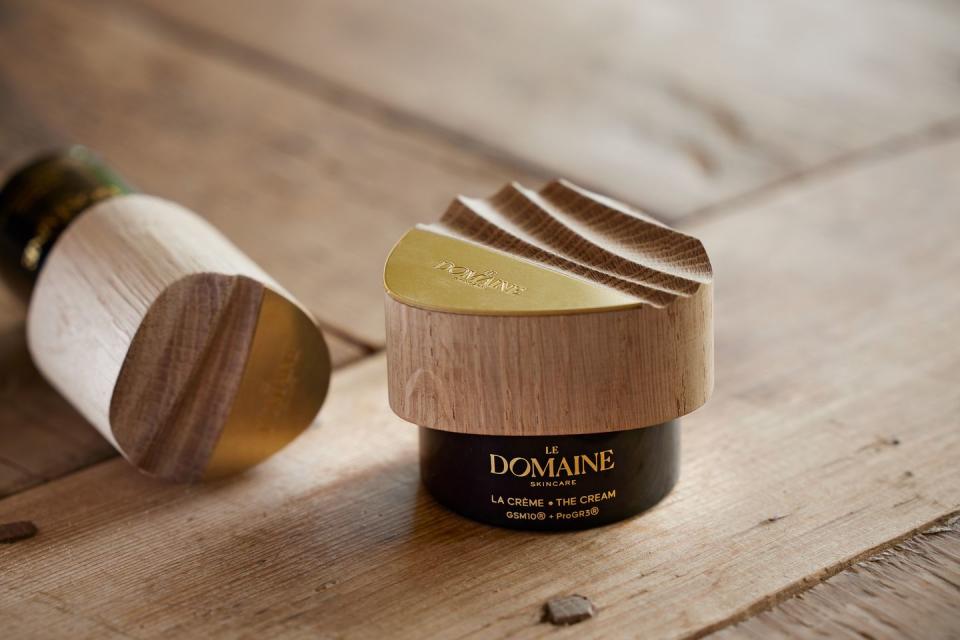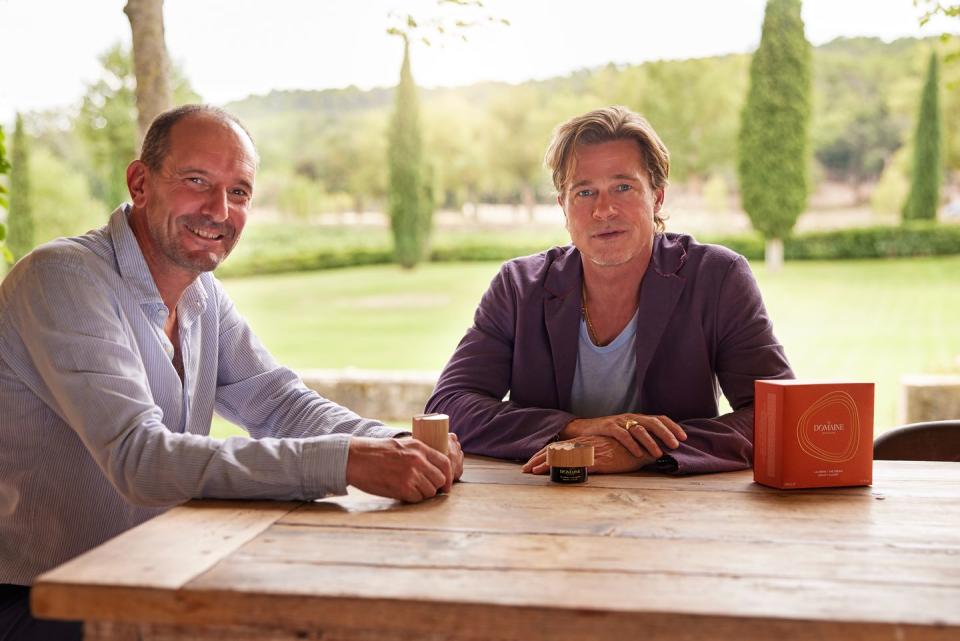Will Brad Pitt's Moisturizer Benjamin Button Your Skin?

- Oops!Something went wrong.Please try again later.
"Hearst Magazines and Yahoo may earn commission or revenue on some items through the links below."
Château Miraval, Brad Pitt’s rosé-producing vineyard in Provence, is so expansive that it takes nearly 20 minutes of driving from the front gate—past vistas of terraced grapevines and lavender fields, through thickets of ancient, lichen-covered trees—before you see any buildings at all. Just outside the guesthouse, a small, fairy-tale-perfect cottage engulfed in vines, Pitt is drifting around a lawn, congenially shaking hands and posing for photos with a small group of international editors who have been invited to the unveiling of his new unisex skincare line, Le Domaine. Tables showcasing the products are grouped beneath a 200-year-old oak tree; the scent of rosemary wafts through the air; Tusca, a truffle-hunting puppy (because yes, truffles grow here too), is lolling in the grass; the rosé is free-flowing. It’s about as idyllic as idyllic gets.
For Pitt, it was important to introduce Le Domaine here, because the line is intrinsically linked with Château Miraval, which he bought with ex-wife Angelina Jolie in 2008. It’s a special place, guided by a very specific philosophy, and it’s Le Domaine’s origin story—along with a battery of clinical studies and heavyweight scientific patents—that differentiate it from the seemingly incessant deluge of celebrity skincare brands (yawn) that have appeared this year.

Pitt’s partner in the project is Marc Perrin, a fifth-generation winemaker whose family is famous for pioneering organic and biodynamic viticulture at Chateau de Beaucastel, a vineyard in the Rhone Valley that they have owned since 1909 (he is also Pitt’s partner at Miraval, where he helped bring the rosé up to snuff for its much-lauded relaunch in 2012). To create Le Domaine, they worked with Dr. Pierre-Louis Teissedre, a professor at the University of Bordeaux Institute of Vine and Wine Science (and author of more than 200 books and papers), who has been analyzing the antioxidant properties of the 13 varieties of grapes grown on Perrin family vineyards for more than a decade, and with Nicolas Levy, a scientist who specializes in the rare rapid-aging disease progeria. From Teissedre, Le Domaine acquired GSM10, an ingredient he developed using upcycled Beaucastel grape pomace—including the seeds of Grenache grapes and the seeds and skin of Syrah and Mourvedre grapes—that has proven exceptionally potent in reducing oxidative stress on skin. And from Levy, a patented molecule dubbed ProGr3 (a combination of resveratrol derived from grapevines, apigenin from chamomile extract, and catechin from green tea) that blunts the activity of progerin, a toxic protein that builds up in cells and contributes to visible signs of aging. Together, these two ingredients put Le Domaine in a league of its own.

For Pitt? They just work. “I’m not going to pretend I know anything about the science,” he says. “Being a film guy, I’ve been sent stuff by brands for decades, and quite frankly I couldn’t tell the difference. I wouldn’t have brought it to market unless I saw that it was working. I don’t know about running from aging, but this idea of being more health-minded with our skin and with our regimen is something that I’m interested in.” He was involved in every step of Le Domaine’s development, from choosing the name to devising the package design to testing every product for over a year (his favorite is the cream, btw), but you will not be seeing Pitt’s famous face, which does indeed look especially glowing and smooth, in any ads. Le Domaine, he insists, “is not meant to be a celebrity brand.”
In keeping with the farming practices at Miraval, it was important to Perrin and Pitt that the skincare be as sustainable as possible. “You know the state we’re in environmentally,” says Pitt. “The idea that there’s no waste in nature is something that has always stuck with me and we really try to apply it here.” To wit, the four products in the range—a cleanser, serum, cream, and a lotion that will be introduced in January—are a minimum of 96 percent natural (ingredients include organic olive oil harvested at Miraval, shea butter, and stem cells from grape flowers), and the packaging is recyclable and refillable, with caps fashioned from discarded scraps of wine-barrel oak.
In the end, Pitt says, Le Domaine is part of a greater, Medici-like mission he has for Miraval. “What I feel here is that it’s a place of great creativity,” he says, waving a hand towards the endless terraces of grapevines shimmering in the afternoon sun. “Historically, it’s always been that. There are remnants of Roman roads and an old Roman enclave from thousands of years ago. It served as a monastery in the 1300s and played a part in the Renaissance.” Pitt wants to make it a place where artists can come to relax and be inspired, a sort of ultra-exclusive retreat with views to die for and rosé on tap. He has even spent the last two years renovating Studio Miraval, which was built in the 1970s by then-owner Jacques Loussier, a French jazz musician. In its heyday, the studio hosted artists like Sade, The Cure, Wham, and Pink Floyd (who legendarily recorded The Wall within its walls); with the help of wunderkind producer Damien Quintard, Pitt has elevated it to the sort of state-of-the-art facility that will bring big names back. “I’ve brought a lot of artist friends out, painters and sculptors, and they all feel the vibe,” he says. “They come and stay for months at a time and make things here. It’s all part of one big vision. And the skincare fits right into that for me.”
You Might Also Like

